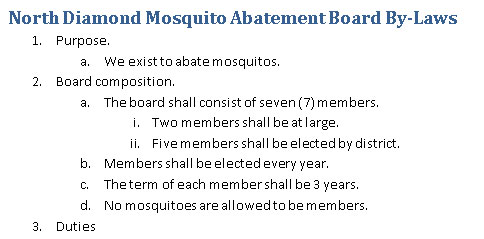Whenever you have more than two items to describe in your Word 2013 document, consider creating a list. To draw attention to such a list, to call it out from the rest of your text, you can try hanging indents, make the first few words bold, or take advantage of the Word bullets and line numbering features.
How to make a bulleted list
In typesetting, a bullet is merely a graphical element, such as a ball or a dot, used to highlight items in a list. The word bullet comes from the French word boulette, which has more to do with food than with round pieces of lead quickly exiting a firearm, like this:
Bang!
Bang!
Bang!
To apply bullets to your text, highlight the paragraphs you want to shoot and choose the Bullets command button, found in the Home tab's Paragraph group. Instantly, your text is not only formatted with bullets but also indented and made all neat and tidy.
You can choose a different bullet style by clicking the menu button next to the Bullets command. Choose your new bullet graphic from the list that appears, or use the Define New Bullet command to dream up your own bullet style.
Because the bullet is a paragraph format, it sticks to the paragraphs you type. To halt the bullets, click the Bullet command button again and they're removed from the paragraph format.
Bullets can also be applied by using Word’s AutoFormat ability.
How to number a list
When a list contains items that are in a certain order or that need to be referenced elsewhere, you can apply numbers or letters or another type of sequential marking. To make it happen, select the paragraphs as a block and choose the Numbering command button from the Paragraph group on the Home tab.
When you click the button, each paragraph is numbered. You can use the Numbering command button’s menu to choose another sequential format, such as letters or Roman numerals, or choose a specific numbering style. Or when none of the predefined formats in the menu pleases you, choose Define New Number Format to create your own numbered list.
List Numbering is a paragraph format. It sticks with every successive paragraph you type until you turn off numbering.
To remove numbers, simply click the Numbering button again. This action removes numbering from the paragraph format.
You can also choose the None command from the Numbering button’s menu to remove numbering from one or more paragraphs.
You can break and resume paragraph numbering, but it’s tricky: Try to apply the numbering as you type paragraphs. Simply press the Backspace key to disable automatic paragraph numbering. To resume numbering, click the Numbering command button again, and the paragraph numbering should continue from where it left off.
How to create a multilevel numbered list
The Multilevel List button, found in the Paragraph group on the Home tab, is used to number a multileveled list, consisting of sublevels and indents. It’s a tricky type of list to create, so pay attention!

You can create a multilevel list from scratch, or you can apply the format to a selected block of text. The secret is to use the Tab and Shift+Tab keys at the start of the paragraph to shuffle the paragraphs higher and lower in the multilevel list hierarchy. It works like this:
Press the Tab key at the start of a paragraph to indent that paragraph to a deeper level in the multilevel list format.
Press the Shift+Tab key combination at the start of a paragraph to unindent a paragraph to a higher level in the multilevel list format.
Press the Enter key twice to end the list.





